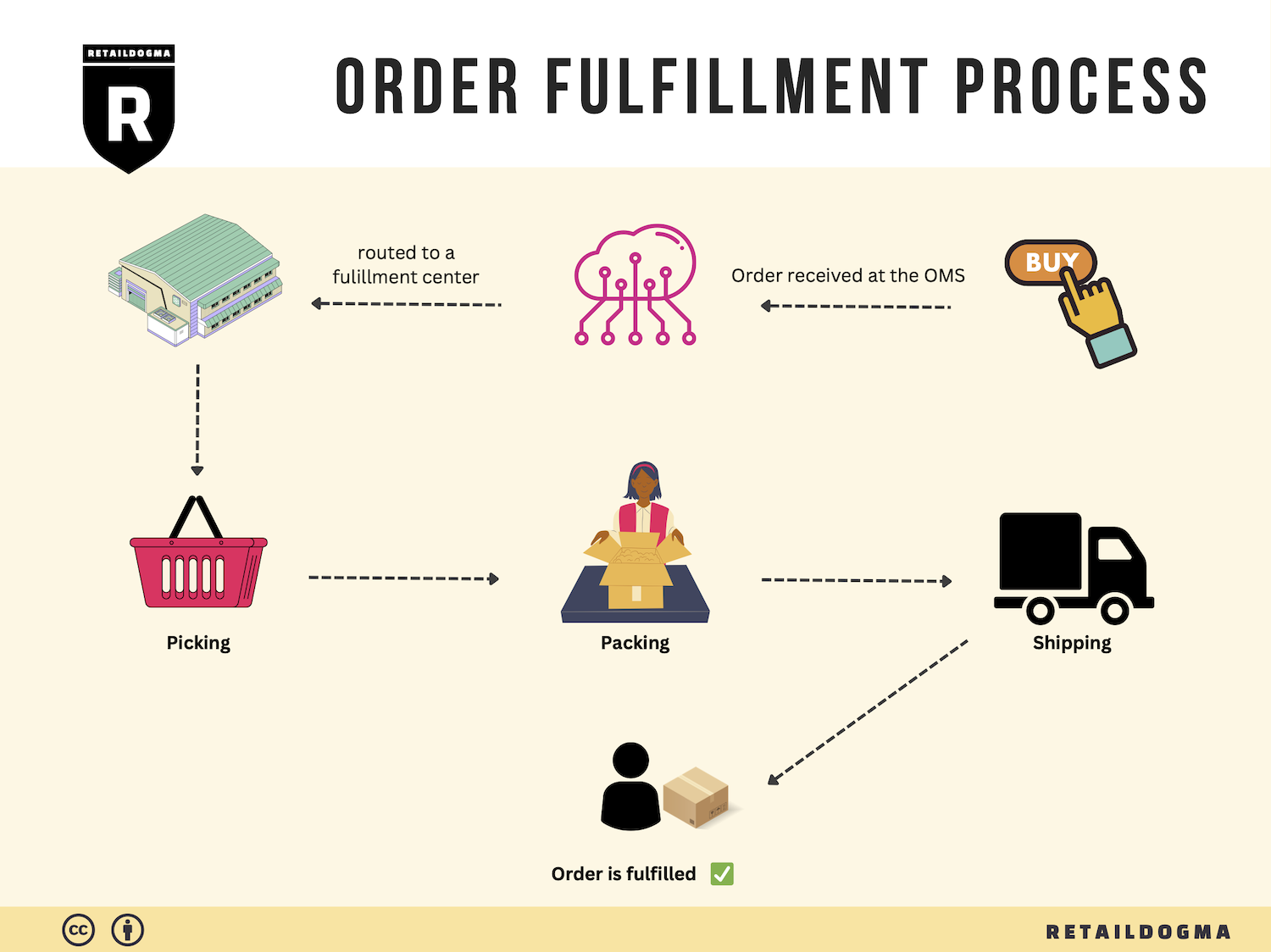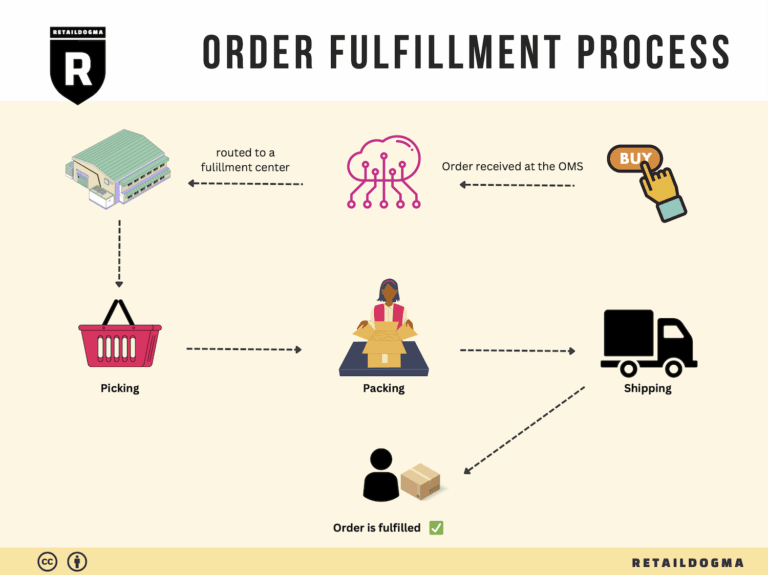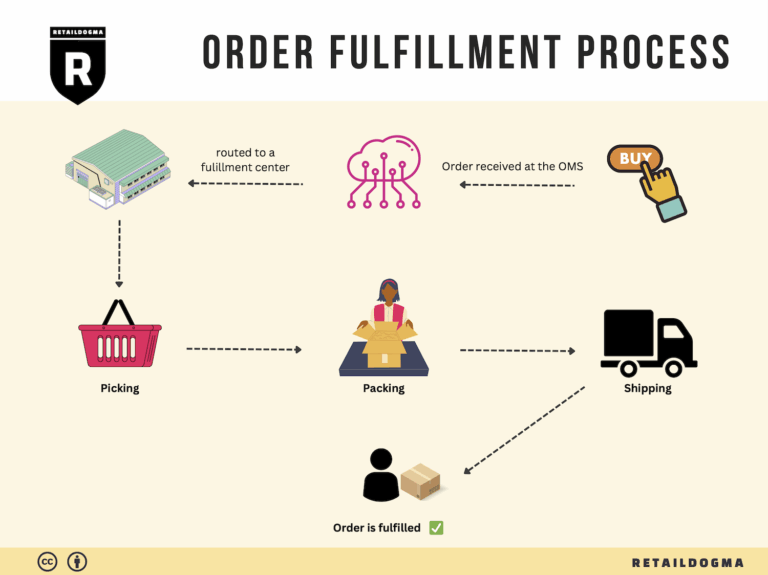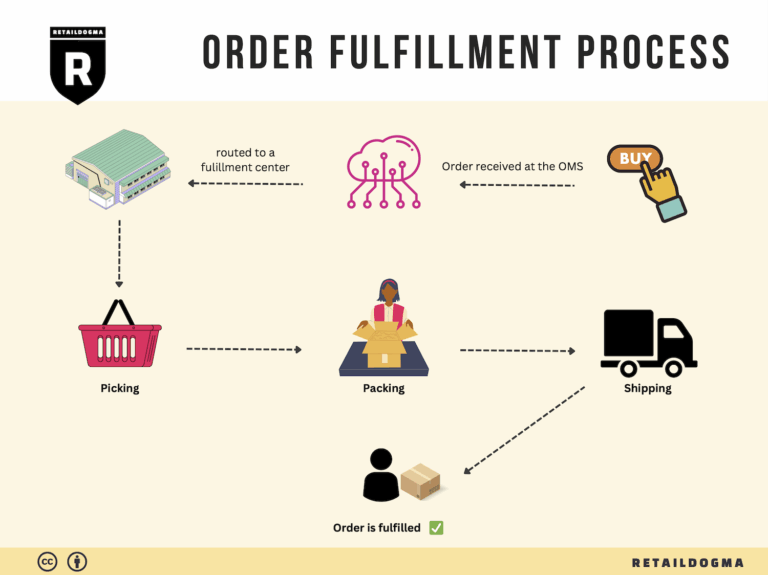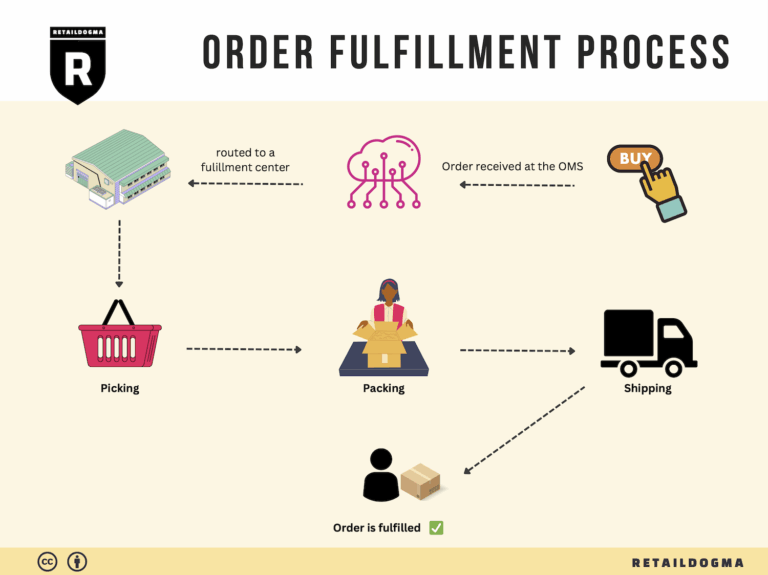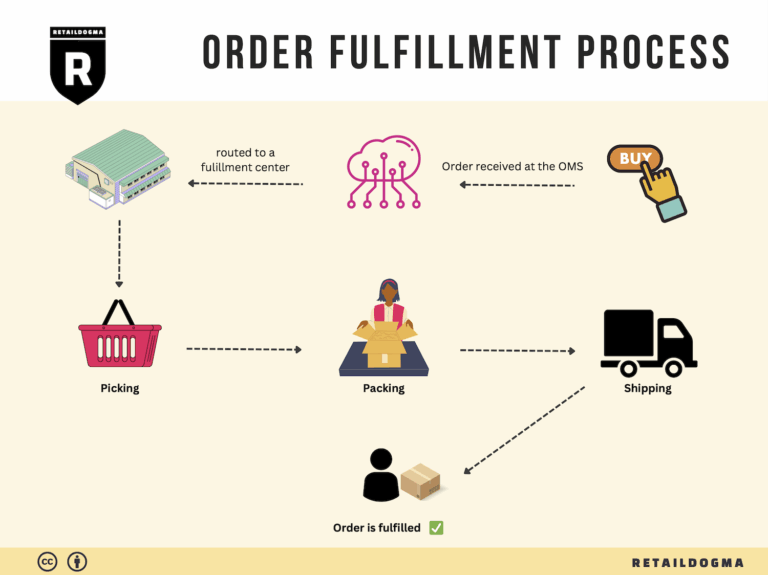What Is A Fulfillment Center? A Complete Guide (2025)
What is E-commerce Fulfillment? An Introduction for Growing Businesses
Understanding E-commerce Fulfillment
As your online business begins to grow, you might find yourself grappling with the complexities of packing and shipping orders. The excitement of increasing sales can quickly turn into a daunting challenge as you juggle inventory management, order processing, and timely delivery. This is where understanding e-commerce fulfillment becomes essential. Simply put, fulfillment is the process of getting a product from your warehouse or fulfillment center to your customer’s doorstep.
Navigating the fulfillment landscape is crucial for scaling your business effectively. In this guide, we will explore various fulfillment models available to online retailers, including third-party logistics (3PL) and Fulfillment by Amazon (FBA). Each model has its own set of advantages and considerations, and understanding these can help you choose the right fit for your operations.
We will also delve into the core services that fulfillment partners typically offer, such as inventory management, order processing, packing, shipping, and returns handling. By having a comprehensive grasp of these services, you can better align your business needs with what potential partners can provide.
Choosing the right fulfillment partner is a critical decision that can impact your business’s efficiency and customer satisfaction. We will guide you through the key factors to consider when evaluating potential partners, including their reliability, technology capabilities, location, and customer service.
Furthermore, pricing is an essential aspect of fulfillment that can significantly affect your bottom line. We will discuss common pricing structures, what to expect in terms of costs, and how to assess the overall value of a fulfillment partner.
The goal of this guide is to empower you with the knowledge needed to make informed decisions about your logistics strategy. By understanding the ins and outs of e-commerce fulfillment, you can streamline your operations, enhance customer experience, and ultimately drive growth for your business. Let’s embark on this journey together to simplify and optimize your fulfillment process.
What You’ll Learn In This Guide
- What is E-commerce Fulfillment? An Introduction for Growing Businesses
- The Order Fulfillment Process: From ‘Buy’ Button to Customer’s Door
- Comparing Fulfillment Models: In-House vs. 3PL vs. Dropshipping
- A Deep Dive into Amazon FBA: Pros, Cons, and Who It’s For
- Core Services Offered by Fulfillment Centers
- How to Choose a Fulfillment Partner: A 6-Point Checklist
- Understanding Fulfillment Pricing: A Breakdown of Common Fees
- Frequently Asked Questions (FAQs) about Fulfillment
- Conclusion: Is Outsourcing Fulfillment the Right Move for Your Business?
- Important Disclaimer
The Order Fulfillment Process: From ‘Buy’ Button to Customer’s Door
1. Receiving Inventory
The order fulfillment process begins with receiving inventory. This step involves the arrival of products at the warehouse or fulfillment center from suppliers or manufacturers. Upon arrival, the inventory is checked against purchase orders to ensure that the correct items and quantities have been delivered. This process often includes using a Stock Keeping Unit (SKU) system, which allows for efficient tracking and management of inventory items.
Receiving inventory is crucial for maintaining accurate stock levels and ensuring that the fulfillment process can proceed smoothly. Any discrepancies, such as damaged goods or missing items, are documented and addressed immediately to prevent delays in order fulfillment. A well-organized receiving process helps to establish a solid foundation for the subsequent steps in the fulfillment chain, ultimately contributing to customer satisfaction.
2. Warehouse Storage
After receiving inventory, the next step is warehouse storage. This involves organizing the received products in a way that maximizes space and facilitates easy access. Depending on the size and type of products, businesses may use various storage solutions, such as shelves, bins, or pallets. Effective warehouse management systems (WMS) often utilize location codes to identify where items are stored, enabling quick retrieval when orders come in.
Proper warehouse storage is essential for maintaining an efficient supply chain. It reduces the time spent searching for items, minimizes the risk of stockouts, and ensures that products are stored under optimal conditions. A well-structured storage system contributes to faster order processing times and can significantly enhance overall operational efficiency.
3. Order Picking
Once a customer places an order, the next step is order picking. This process involves selecting the items from storage that correspond to the customer’s order. Pickers typically use a pick list, which details the items and their locations within the warehouse, guiding them to the correct shelves or bins.
Order picking is a critical step in the fulfillment process, as it directly affects order accuracy and speed. Efficient picking methods, such as batch picking (where multiple orders are picked simultaneously) or zone picking (where pickers are assigned specific areas of the warehouse), can greatly enhance productivity. Accurate order picking minimizes the risk of errors, leading to higher customer satisfaction and reduced returns.
4. Order Packing
After the items are picked, they move to the order packing stage. Here, the products are carefully packaged for shipment. This involves selecting appropriate packaging materials that protect the items during transit and prevent damage. Businesses often use packing slips, which include details about the order, to ensure that the correct items are included in the shipment.
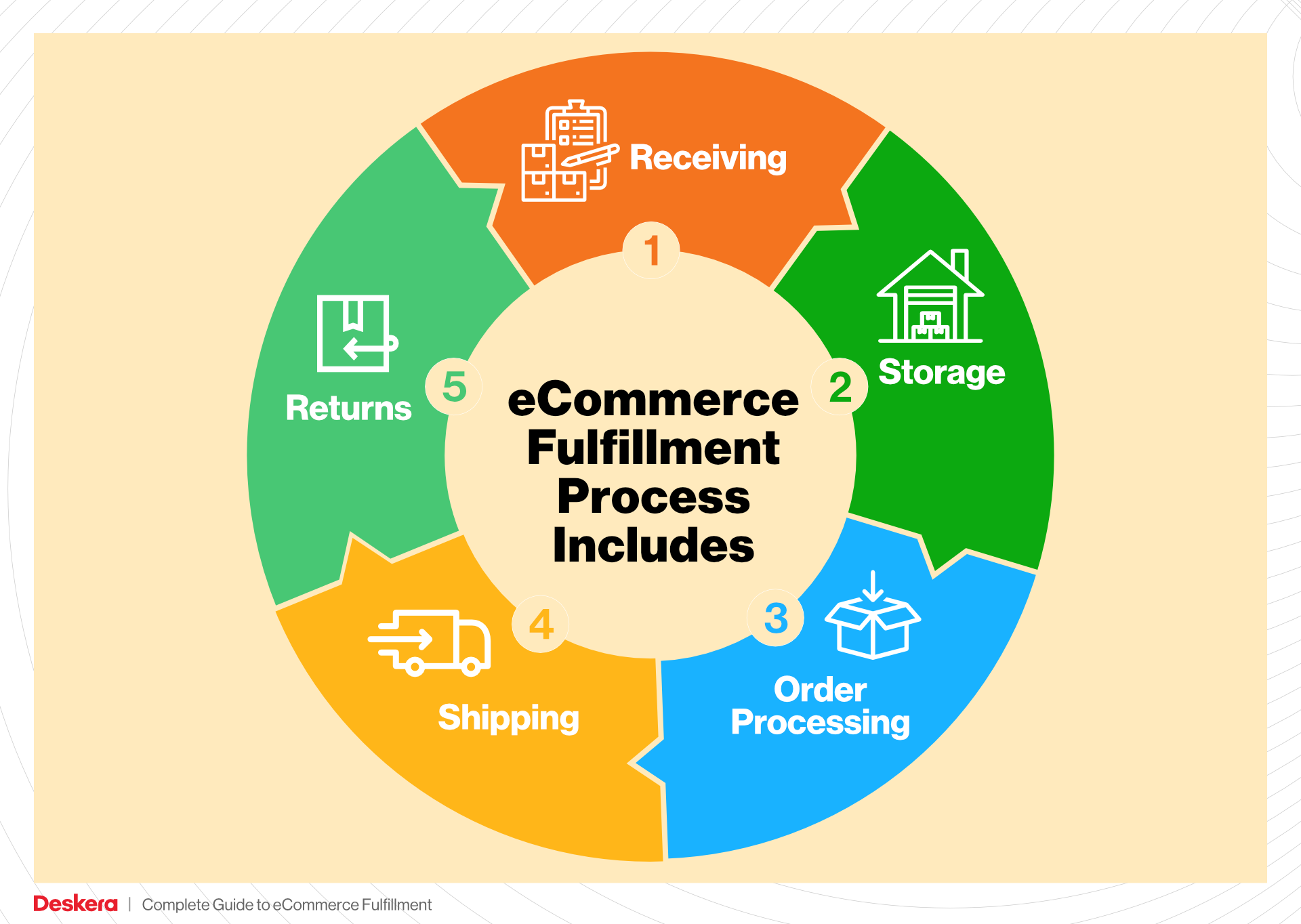
Packing is vital because it not only safeguards the products but also enhances the customer’s unboxing experience. A well-packed order reflects professionalism and attention to detail, reinforcing the brand’s image. Additionally, optimizing packing processes can lead to cost savings in shipping, as well as reduced returns due to damage during transit.
5. Shipping & Delivery
The final step in the order fulfillment process is shipping and delivery. Once the order is packed, it is labeled and dispatched to the chosen shipping carrier. The shipping method may vary based on factors such as delivery speed and cost, and it is crucial to choose a reliable carrier that can meet the customer’s expectations.
Effective shipping and delivery are essential for maintaining customer satisfaction. Timely delivery boosts brand reputation and encourages repeat business. Businesses should also implement tracking systems, allowing customers to monitor their orders in real-time. This transparency not only enhances the customer experience but also reduces inquiries about order status, streamlining communication between the business and its customers.
In conclusion, the order fulfillment process is a complex but essential part of e-commerce operations. Each step, from receiving inventory to shipping and delivery, plays a critical role in ensuring that customers receive their orders accurately and promptly. By optimizing these processes, businesses can improve operational efficiency, enhance customer satisfaction, and ultimately drive growth in their e-commerce ventures.
Comparing Fulfillment Models: In-House vs. 3PL vs. Dropshipping
Fulfillment Model Comparison
| Model | Who Handles Inventory | Best For (Business Stage) | Key Advantage | Key Disadvantage |
|---|---|---|---|---|
| In-House Fulfillment | The business itself | Established businesses with stable demand | Full control over inventory and processes | High operational costs and complexity |
| Third-Party Logistics (3PL) | A third-party provider | Growing businesses looking to scale | Access to expertise and infrastructure | Less control over inventory and processes |
| Dropshipping | The supplier | Startups or small businesses testing products | Low upfront investment and risk | Lower profit margins and reliance on suppliers |
In-House Fulfillment
In-house fulfillment involves managing the entire inventory and shipping process within the business itself. This model is typically adopted by established companies that have a stable demand for their products. The key advantage of in-house fulfillment is the level of control it provides. Businesses can oversee the entire process, from inventory management to order processing and shipping, allowing for tailored customer service and operational flexibility. Additionally, this model can enhance brand identity, as businesses can directly influence how their products are packed and shipped. However, the downside is significant: maintaining in-house fulfillment can lead to high operational costs, including warehousing, staffing, and technology investments. It also introduces complexities in logistics management, especially as order volume increases. As businesses scale, they may find it challenging to keep up with growing customer expectations for faster delivery times and improved service levels.
Third-Party Logistics (3PL)
Third-party logistics (3PL) refers to outsourcing logistics and fulfillment services to specialized providers. This model is ideal for growing businesses that are looking to scale their operations without the burden of managing logistics internally. A 3PL partner handles warehousing, order fulfillment, shipping, and sometimes even customer service, allowing the business to focus on core activities like marketing and product development. The primary advantage of using a 3PL is access to expertise and infrastructure that would otherwise require substantial investment. Companies can benefit from the 3PL’s established networks, advanced technology systems, and logistics best practices, which can lead to improved efficiency and reduced shipping costs. However, the trade-off is a loss of direct control over inventory and fulfillment processes. Businesses may encounter challenges such as miscommunication with their 3PL partner, discrepancies in service quality, and potential delays in shipping. Establishing a reliable partnership is critical to mitigate these risks.
Dropshipping
Dropshipping is a fulfillment model where the retailer does not keep products in stock but instead transfers customer orders directly to a wholesaler or manufacturer, who then ships the products directly to the customer. This model is particularly appealing to startups or small businesses testing new products, as it requires minimal upfront investment and reduces financial risk. The primary advantage of dropshipping is the low barrier to entry; entrepreneurs can launch e-commerce stores without the need for significant capital to purchase inventory or manage warehousing. Additionally, dropshipping allows for a broad product range, enabling businesses to test various items without the commitment of holding stock. However, the model comes with notable disadvantages, including lower profit margins due to reliance on suppliers and potential issues with product quality and shipping times. Since businesses depend heavily on their suppliers for inventory management and fulfillment, any delays or errors on the supplier’s part can directly impact customer satisfaction and brand reputation. Furthermore, dropshipping can lead to challenges in maintaining consistent product availability and managing customer expectations.
In conclusion, the choice of fulfillment model significantly impacts an e-commerce business’s operational efficiency, customer satisfaction, and overall scalability. Each model has its unique advantages and disadvantages, and the best option will depend on the specific needs, resources, and growth stage of the business. Understanding these factors is crucial for making an informed decision that aligns with long-term business goals.
A Deep Dive into Amazon FBA: Pros, Cons, and Who It’s For
Understanding Fulfillment by Amazon (FBA)
Fulfillment by Amazon (FBA) is a service that allows e-commerce sellers to store their products in Amazon’s fulfillment centers. Amazon then takes care of storage, packaging, and shipping of these products directly to customers. This service streamlines the logistics process for sellers, enabling them to focus on their core business activities, such as marketing and product development.
When a customer places an order for a product listed by an FBA seller, Amazon handles the entire fulfillment process. This includes picking the product from the warehouse, packing it, and shipping it to the customer. Additionally, Amazon provides customer service and manages returns for these orders, offering a seamless experience for both sellers and buyers.
How FBA Works
-
Set Up Your FBA Account: Sellers need to create an Amazon seller account and enroll in FBA. This involves providing business information and agreeing to Amazon’s terms.
-
List Products: Sellers can either create new listings or convert existing listings to FBA. Each product needs to meet Amazon’s guidelines, including packaging and labeling requirements.
-
Ship Inventory to Amazon: Sellers prepare their products and ship them to Amazon’s designated fulfillment centers. Amazon provides shipping guidelines to ensure the products arrive in good condition.
-
Storage and Fulfillment: Once the products are received, they are stored in Amazon’s warehouses. When an order is placed, Amazon takes care of picking, packing, and shipping the product to the customer.
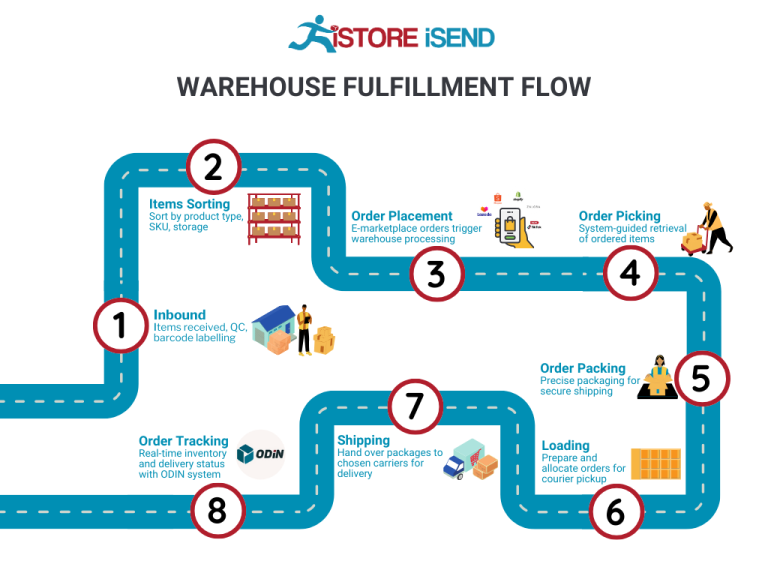
-
Customer Service and Returns: Amazon handles all customer inquiries and returns for FBA orders, allowing sellers to focus on other aspects of their business.
Pros of Fulfillment by Amazon (FBA)
1. Prime Eligibility
One of the most significant advantages of FBA is that products become eligible for Amazon Prime. This means that Prime members can enjoy free two-day shipping on these items, which significantly increases the likelihood of purchases. With millions of Prime members, this can lead to higher sales volumes for sellers.
2. Customer Trust
Amazon is a trusted name in e-commerce. By using FBA, sellers can leverage Amazon’s reputation for reliability and customer service. Customers are more likely to purchase products that are fulfilled by Amazon due to the assurance of quick shipping and hassle-free returns.
3. Multi-Channel Fulfillment
FBA is not limited to just Amazon.com. Sellers can also use FBA to fulfill orders from their own websites or other sales channels. This multi-channel fulfillment capability allows businesses to centralize their inventory and streamline their logistics.
4. Time Savings
Outsourcing fulfillment to Amazon frees up time for sellers to focus on growing their business rather than managing logistics. This can be particularly beneficial for small business owners or entrepreneurs who may not have the resources to handle shipping and customer service.
5. Scalability
FBA allows sellers to scale their business without the need to invest heavily in warehousing and logistics infrastructure. As sales increase, Amazon can accommodate the growing inventory and fulfillment needs with ease.
Cons of Fulfillment by Amazon (FBA)
1. High Fees
While FBA provides numerous benefits, it comes at a cost. Sellers are charged various fees, including storage fees for products stored in Amazon’s warehouses and fulfillment fees for each order shipped. These fees can add up quickly, especially for sellers with large inventories or low-margin products.
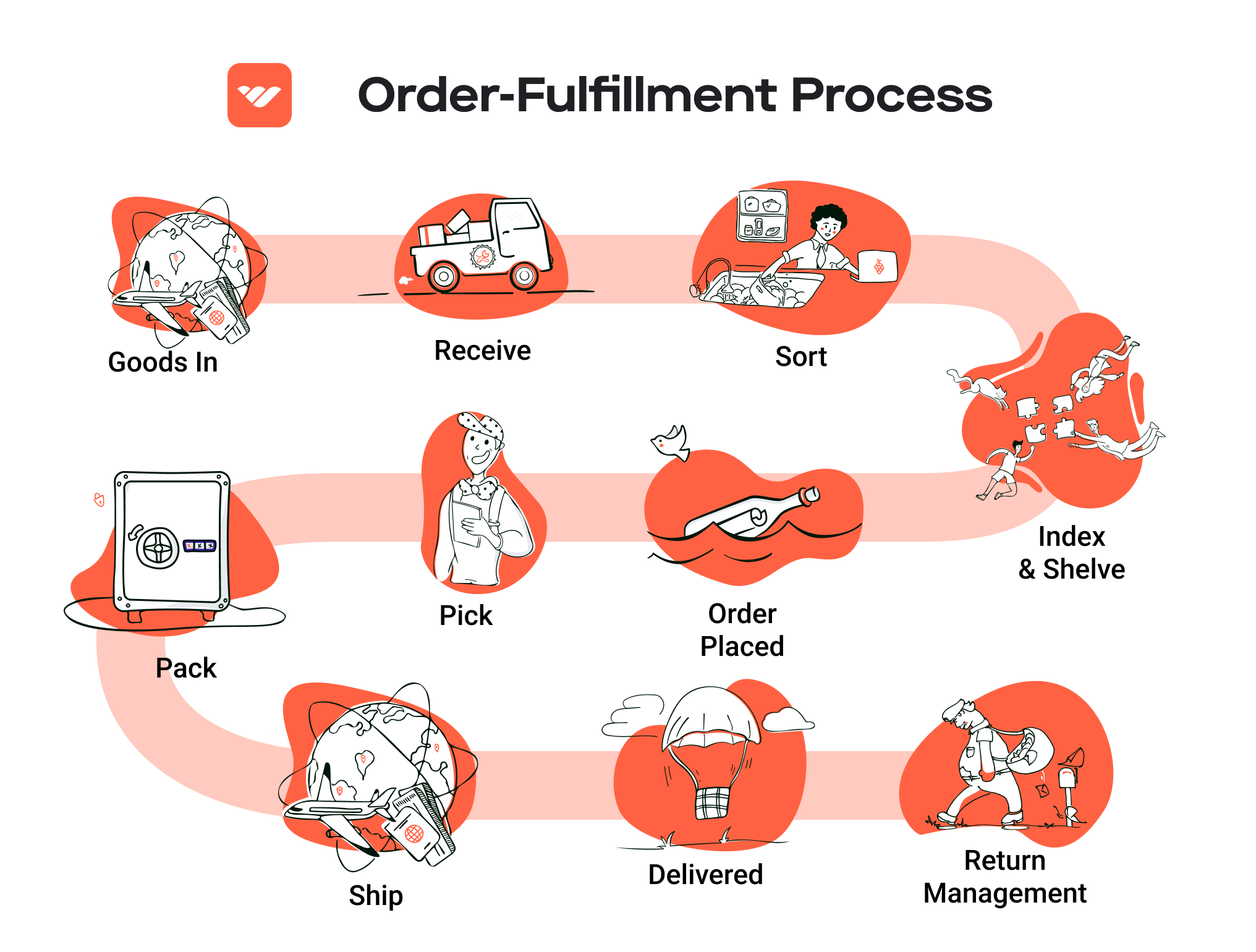
2. Strict Inventory Rules
Amazon has strict inventory management policies that sellers must adhere to. This includes limitations on the amount of inventory that can be stored and specific guidelines for packaging and labeling. Sellers who do not comply with these rules may face additional fees or inventory removal.
3. Commingling Risks
When using FBA, sellers’ products may be stored alongside those from other sellers. This commingling can lead to issues such as shipping the wrong item or receiving returns for products not sold by the seller. To mitigate this risk, sellers can opt for stickered inventory, but this may incur additional costs.
4. Less Control Over Branding
With FBA, Amazon handles the packaging and shipping process. While this can be convenient, it also means that sellers have less control over how their products are presented to customers. This can impact branding efforts, as sellers may not be able to include personalized packaging or marketing materials.
5. Inventory Management Challenges
Managing inventory levels can become complex with FBA. Sellers must monitor stock levels closely to avoid stockouts or excess inventory, which can lead to increased fees. Additionally, seasonal fluctuations in demand can complicate inventory forecasting.
Who is FBA Best For?
Fulfillment by Amazon is an excellent option for several types of sellers:
-
Small to Medium-Sized Businesses: Businesses looking to scale quickly without investing heavily in logistics can benefit from FBA’s capabilities.
-
E-commerce Entrepreneurs: Individuals starting an online business who want to focus on product sourcing and marketing rather than logistics will find FBA advantageous.
-
Brands with High Sales Volume: Established brands that have a steady sales volume can leverage FBA to improve efficiency and enhance customer satisfaction.
-
Sellers with Limited Warehousing Options: For sellers who do not have the capacity or resources to manage their own warehousing and fulfillment, FBA provides a practical solution.
In conclusion, Fulfillment by Amazon offers a powerful way for e-commerce sellers to streamline their logistics operations, enhance customer trust, and potentially increase sales. However, it is essential to weigh the benefits against the costs and challenges associated with the service. By understanding how FBA works and who it serves best, sellers can make informed decisions that align with their business goals.
Core Services Offered by Fulfillment Centers
Inventory Management & Warehousing
Inventory management and warehousing are foundational services provided by fulfillment centers that enable e-commerce businesses to effectively store and track their products. Fulfillment centers utilize sophisticated inventory management systems that allow businesses to monitor stock levels in real-time, ensuring that they can meet customer demand without overstocking or running out of products.
Benefits:
1. Optimized Stock Levels: By maintaining accurate inventory counts, businesses can avoid costly stockouts and overstock situations. This leads to improved cash flow and reduced holding costs.
2. Enhanced Visibility: Advanced inventory management systems provide e-commerce businesses with detailed insights into stock movement, enabling better forecasting and planning.
3. Space Efficiency: Fulfillment centers are equipped with storage solutions that maximize space utilization, allowing businesses to store a greater volume of products in a smaller footprint.
4. Scalability: As a business grows, fulfillment centers can easily adjust their storage capabilities to accommodate increasing inventory levels without the need for significant capital investment in additional warehouse space.
Pick and Pack Services
Pick and pack services involve the process of selecting items from inventory (picking) and preparing them for shipment (packing). Fulfillment centers employ efficient workflows and technology to streamline this process, ensuring that orders are fulfilled accurately and quickly.
Benefits:
1. Speed and Efficiency: Fulfillment centers utilize optimized picking routes and automated systems to reduce the time it takes to fulfill orders, which is crucial for maintaining customer satisfaction, especially in an era of same-day and next-day deliveries.
2. Accuracy: With barcode scanning and inventory management software, fulfillment centers can minimize picking errors, ensuring that customers receive the correct items. This reduces returns and enhances brand reputation.
3. Customization: Many fulfillment centers offer tailored packing solutions, including branded packaging, which can enhance the customer experience and foster brand loyalty.
4. Cost-Effectiveness: By outsourcing pick and pack services, businesses can save on labor costs and reduce the overhead associated with managing an in-house fulfillment operation.
Kitting and Assembly
Kitting and assembly services involve the grouping of individual items into ready-to-ship sets or the assembly of products that require multiple components. This service is particularly beneficial for businesses that sell products that need to be combined or packaged together before shipping.
Benefits:
1. Streamlined Operations: By outsourcing kitting and assembly to fulfillment centers, businesses can streamline their operations and focus on core activities such as marketing and product development.
2. Improved Order Accuracy: Fulfillment centers specialize in these processes, leveraging trained staff and efficient workflows to ensure that kits are assembled correctly and shipped without errors.
3. Reduced Time to Market: With kitting and assembly handled by professionals, businesses can bring new products to market faster, responding quickly to consumer demand and trends.
4. Enhanced Customer Experience: Offering bundled products or kits can enhance the shopping experience, providing customers with a convenient way to purchase related items together, potentially increasing average order value.
Returns Management (Reverse Logistics)
Returns management, often referred to as reverse logistics, is a critical service offered by fulfillment centers that handles the process of returning products from customers back to the inventory. This service is essential for maintaining customer satisfaction and managing the complexities of e-commerce returns.
Benefits:
1. Efficient Processing: Fulfillment centers implement streamlined processes for handling returns, ensuring that products are quickly inspected, restocked, or disposed of as needed. This efficiency helps businesses maintain accurate inventory levels.
2. Customer Satisfaction: A smooth returns process enhances the customer experience, making it more likely that customers will shop with the business again. Easy returns can reduce friction and increase customer loyalty.
3. Data Insights: Fulfillment centers can provide valuable data on return trends, helping businesses identify issues with specific products or categories. This information can inform product development and inventory decisions.
4. Cost Reduction: By managing returns effectively, fulfillment centers help reduce the costs associated with reverse logistics, including shipping and restocking fees, thereby improving overall profitability.
In conclusion, leveraging the core services offered by fulfillment centers can significantly enhance the operational efficiency of e-commerce businesses. By focusing on inventory management, pick and pack services, kitting and assembly, and returns management, businesses can scale effectively while delivering an exceptional customer experience.
How to Choose a Fulfillment Partner: A 6-Point Checklist
Location & Warehouse Network
Choosing a fulfillment partner with a strategic location and an extensive warehouse network is crucial for optimizing shipping times and costs. A partner’s proximity to your customer base can dramatically reduce shipping times, enhancing customer satisfaction.
Questions to Ask:
– What locations do you have warehouses in, and how do they align with my target market?
– How many distribution centers do you operate, and what is their capacity?
– Do you have a plan for expanding your network to meet future demands?
Technology & Integrations
In today’s digital landscape, the technology used by your fulfillment partner plays a pivotal role in streamlining operations. Efficient integration with your existing e-commerce platforms can enhance order processing, inventory management, and real-time tracking.
Questions to Ask:
– What order management system (OMS) do you use, and is it compatible with my e-commerce platform?
– Do you offer real-time inventory tracking, and how can I access this data?
– Can your systems support automation and API integrations for seamless operations?
Specializations (e.g., Cold Storage, Oversized Items)
Different businesses have unique fulfillment needs. If your products require specialized handling—such as cold storage for perishables or accommodations for oversized items—it’s essential to partner with a fulfillment center that can meet those specific requirements.
Questions to Ask:
– Do you have facilities equipped for special storage conditions, such as temperature control?
– What types of products do you specialize in handling, and can you provide case studies or references?
– How do you manage the storage and handling of oversized or fragile items?
Scalability & Capacity
As your business grows, your fulfillment partner must be able to scale operations accordingly. Assessing a partner’s capacity to handle increased volume and their flexibility in adjusting to your needs is critical for long-term success.
Questions to Ask:
– What is your current capacity for order fulfillment, and how do you manage peak seasons?
– How quickly can you scale operations if my order volume increases significantly?
– Do you have contingency plans in place for unexpected surges in demand?
Pricing and Contracts
Understanding the pricing structure and contractual obligations of a fulfillment partner is vital to maintaining your profit margins. Transparent pricing can prevent unexpected costs and help you budget effectively.
Questions to Ask:
– What is included in your pricing model (e.g., storage fees, pick and pack fees, shipping costs)?
– Are there any hidden fees I should be aware of?
– What are the terms of the contract, and is there flexibility for renegotiation as my business evolves?
Customer Support & Reviews
Quality customer support is a cornerstone of a successful partnership. Responsive and knowledgeable support can help resolve issues quickly and efficiently, minimizing disruptions in your operations.
Questions to Ask:
– What type of customer support do you offer (e.g., phone, email, live chat), and what are your response times?
– Can you provide references or case studies that demonstrate your customer service effectiveness?
– How do you handle disputes or issues that arise during the fulfillment process?
In conclusion, selecting the right fulfillment partner is a critical decision that can significantly impact your e-commerce operations. By using this checklist, you can ensure that you choose a partner that aligns with your business goals, meets your operational needs, and supports your long-term growth strategies. Remember, a successful partnership is built on transparency, communication, and mutual understanding.
Understanding Fulfillment Pricing: A Breakdown of Common Fees
Initial Setup Fees
When partnering with a fulfillment center, many companies impose an initial setup fee to cover the administrative costs associated with onboarding your business. This fee typically includes creating your account, integrating your e-commerce platform, and establishing your inventory management system.
The amount can vary widely based on the complexity of your operations and the fulfillment provider you choose. Some providers may charge a flat fee, while others might base it on the volume of products you plan to store or ship. It’s crucial to inquire about what the setup fee includes, as some companies may offer a reduced fee or waive it entirely for new clients.
Receiving Fees
Receiving fees are charged when your inventory arrives at the fulfillment center. This fee covers the costs associated with unloading, inspecting, and logging your products into the warehouse management system.
Typically calculated per pallet or per item, receiving fees can vary based on several factors, including the complexity of your products (e.g., fragile items may require more careful handling) and the volume of inventory being processed. For businesses looking to scale, it’s important to understand how often you will be sending inventory to the fulfillment center and to factor these costs into your overall budgeting.
Storage Fees (per pallet/bin)
Storage fees are incurred for the space your inventory occupies within the fulfillment center. These fees are usually calculated on a per pallet or per bin basis and are often charged monthly.
Storage costs can vary based on the type of products you are storing. For example, larger or bulkier items may cost more to store than smaller, standard-sized products. Additionally, many fulfillment centers implement a tiered pricing structure, where the cost per pallet decreases as you store more inventory. Understanding these nuances can help you optimize your inventory levels to minimize storage fees.
Pick & Pack Fees (per item/order)
Pick and pack fees are charged for the process of selecting items from your inventory and preparing them for shipment. This fee is typically calculated on a per item or per order basis.
The complexity of your orders can significantly affect these fees. For instance, if your orders frequently include multiple items or require special packaging, the pick and pack fees may be higher. Some fulfillment centers also offer tiered pricing based on order volume, which can provide cost savings for businesses with high order frequencies.
To manage costs effectively, consider optimizing your product offerings and order processes to streamline the pick and pack operation.
Shipping Fees
Shipping fees are one of the most significant costs associated with fulfillment services. These fees cover the transportation of your products from the fulfillment center to your customers. Shipping fees can be influenced by several factors, including the shipping method chosen (standard vs. expedited), the weight and dimensions of the package, and the destination.
Most fulfillment centers negotiate shipping rates with carriers to offer competitive pricing to their clients. Understanding how these shipping costs are calculated and the various options available (e.g., ground, air, international shipping) will enable you to select the best shipping strategy for your business needs.
Tips for Getting an Accurate Quote
-
Detailed Inventory List: Provide a comprehensive list of your products, including dimensions, weights, and any special handling requirements. This will help fulfillment centers give you more accurate storage and shipping fee estimates.
-
Understand Your Needs: Be clear about your expected order volume, shipping frequency, and any seasonal fluctuations in demand. This information can significantly impact the pricing structure offered by fulfillment providers.
-
Ask About Discounts: Inquire if the fulfillment center offers discounts for larger volumes or long-term commitments. Some providers may have tiered pricing that can lead to substantial savings.
-
Review All Fees: Ensure that you understand all potential fees involved, including hidden costs such as returns processing or special packaging.
-
Compare Multiple Providers: Don’t settle on the first quote you receive. Comparing several fulfillment centers will give you a better understanding of the market and help you identify the best option for your business.
By comprehensively understanding these fulfillment pricing models and strategically assessing your logistics needs, you can make informed decisions that will help scale your e-commerce business efficiently.
Frequently Asked Questions (FAQs) about Fulfillment
1. What is an Amazon Hub Locker?
An Amazon Hub Locker is a self-service kiosk that allows customers to pick up their Amazon packages at a convenient location. These lockers are typically found in public areas such as convenience stores, grocery stores, and postal centers, providing a secure alternative for receiving packages without needing to wait at home.
2. How do I use an Amazon Hub Locker for my orders?
To use an Amazon Hub Locker, select it as your delivery option during checkout on Amazon. Ensure your items meet the eligibility criteria (e.g., weight and size limits). After placing your order, you’ll receive a unique pickup code via email or SMS, which you can use to access your package at the chosen locker location.
3. What types of Amazon Hub Lockers are available?
There are three main types of Amazon Hub Lockers:
– Amazon Hub Locker: Standard lockers located in public spaces.
– Amazon Hub Apartment Locker: Designed for apartment complexes, allowing residents to receive packages securely.
– Amazon Hub Locker+: Locations with additional support from Amazon associates for assistance.
4. What are the eligibility criteria for using an Amazon Hub Locker?
To be eligible for delivery to an Amazon Hub Locker, your order must:
– Weigh under 10 pounds.
– Have dimensions not exceeding 16 x 12 x 14 inches.
– Be sold or fulfilled by Amazon.
– Have a total value below $5,000.
– Not include hazardous materials or items shipped from international locations.
5. How can I find an Amazon Hub Locker near me?
You can locate Amazon Hub Lockers through your Amazon account by navigating to the Amazon Pickup page. Enter your address, ZIP code, or a specific landmark to view available locker locations. You can also add your preferred locker to your address book for future orders.
6. What are the benefits of using Amazon Hub Lockers?
Using Amazon Hub Lockers offers several advantages:
– Convenience: Pick up packages at your leisure without needing to wait for deliveries.
– Security: Lockers provide a secure environment to protect packages from theft.
– Flexibility: Access lockers during extended hours, including weekends.
– Accessibility: Ideal for individuals without a stable address, such as travelers or those in shared accommodations.
7. Are there any downsides to using Amazon Hub Lockers?
Yes, there are some limitations:
– Limited delivery options: Not all lockers support same-day or one-day shipping.
– Availability: Lockers may be full or not conveniently located, especially in less populated areas.
8. What is a fulfillment center, and how does it differ from a warehouse?
A fulfillment center is a specialized facility designed for order processing, inventory management, and shipping directly to customers. Unlike traditional warehouses that primarily store goods, fulfillment centers focus on efficiently handling orders, including packing and shipping, often integrating with e-commerce platforms to streamline operations.
9. What is a 3PL, and how can it benefit my business?
A Third-Party Logistics (3PL) provider is a company that manages a business’s logistics and supply chain operations, including warehousing, fulfillment, and shipping. Partnering with a 3PL can help businesses scale by reducing overhead costs, improving delivery times, and allowing them to focus on core activities like marketing and product development.
10. How much do fulfillment services typically cost?
The cost of fulfillment services can vary widely depending on factors such as order volume, storage needs, and specific services provided (e.g., packing, shipping, returns handling). Generally, fees may include storage costs (per cubic foot), picking and packing fees (per item), and shipping charges. It’s advisable to compare several providers and consider your specific needs to find the best pricing structure.
Conclusion: Is Outsourcing Fulfillment the Right Move for Your Business?
The Case for Outsourcing Fulfillment
In the fast-paced world of e-commerce, efficient fulfillment is critical to maintaining customer satisfaction and scaling your business. Outsourcing fulfillment can offer significant advantages that can help you streamline operations and focus on core business activities.
One of the primary benefits is time savings. By partnering with a fulfillment service, you can delegate logistics tasks such as inventory management, packaging, and shipping. This not only frees up valuable time but also allows you to concentrate on strategic initiatives like marketing and product development, which are essential for growth.
Scalability is another compelling reason to consider outsourcing. As your business grows, so do the complexities of order fulfillment. A reliable fulfillment partner can adapt to your changing needs, whether you’re experiencing seasonal spikes in demand or expanding into new markets. This flexibility ensures that you can meet customer expectations without the burden of managing logistics in-house.
Additionally, fulfillment services bring expertise to the table. These partners often have advanced technology and processes in place, which can enhance accuracy and efficiency. Their experience in handling returns, managing inventory, and optimizing shipping routes can lead to significant cost savings and improved service levels.
However, it’s crucial to choose the right fulfillment partner that aligns with your business goals. A misaligned partnership can lead to inefficiencies and customer dissatisfaction.
As you evaluate your current shipping processes, consider conducting an audit to identify areas for improvement. Ask yourself if outsourcing fulfillment could be the strategic move that propels your business forward. Take the time to research potential partners and assess how they can support your growth trajectory. The right decision could transform your operations, allowing you to deliver exceptional service while positioning your business for success.
Important Disclaimer
⚠️ Important Disclaimer
The information in this guide is for educational purposes. Fulfillment services, pricing, and platform features change frequently. Always conduct your own due diligence and consult with providers directly before making business decisions.
